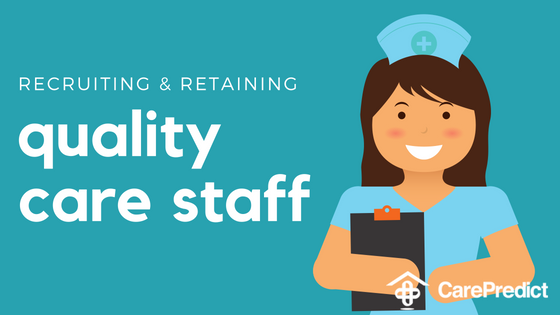Best Practices to Hire and Retain Quality Care Staff

Staff retention is a chronic problem for senior living communities and their management. The average turnover rate for all employees is nearly 35% per year, according to Hospital & Healthcare Compensation Service’s 2016 survey of over 1,300 assisted living communities.
Staff with the most day-to-day resident contact—resident assistants/personal care aides and dining services—have peak turnover rates of 36%. Other front-line staff, such as nurses and medication aides, is not much lower with rates of 20-30%.
Poor staff retention negatively affects all parts of a community’s operations. It can decrease occupancy. Families ask about turnover during the selection process. Residents cite the constantly changing faces of their caregivers as a leading reason to leave. It decreases the quality of care. Better Jobs, Better Care (BJBC), a major retention study, found that disruption in caregiving services could compromise resident well-being and further stress employees, contributing to the injury of both. It increases enterprise expense. BJBC conservatively estimated that the direct cost of replacing one front-line worker was at least $2,500 or, using another metric, as high as 25% of annual compensation.
Healthy, happy, and connected residents are less likely to leave—and to remain in your community longer.
Here are 4 approaches to lower your staff turnover:
- Retention starts with a good hire
Make sure that job descriptions are frequently updated and fully descriptive. Don’t wait for the vacancy as most do—be proactive in lining up potential quality candidates, including referrals from present employees. In the interview process, check for the right mix of caring, dedication, and resilience in a physically and often emotionally demanding position. Take the time to check background and references. Once hired, structure onboarding to prepare the new employee for their new job, be acquainted with all aspects of the community, and to understand the community’s core values. Supervisory training should also strongly support new hires and new hire training.
- Offer competitive wages and benefits that recognize the worker’s value
The pay of most direct care workers in long-term care is consistently in the bottom quarter of U.S. hourly wages and less than half the national average. Many jobs are part-time. A combination of higher wages, bonuses based on performance, healthcare benefits, and paid time off can have a significant effect on improved retention and be a major differentiator in hiring quality staff (Senior Living 100, Building the Health Care Workforce, NIH).
- Support your staff with training, uations, and career paths
Continuously engage staff, reinforce your goals and mission through ongoing professional development and staff interaction. These can include interdisciplinary care plan meetings, supervisory training, coaching workshops, team building, and opportunities for professional growth (in-house and external). Use employee recognition programs to identify and reward those who go ‘above and beyond’—cash bonuses or gift cards are always appreciated. Provide feedback through informal and at least one annual formal skill and performance uations. Introduce discussion of career paths, which reinforce the employee’s long-term value to the community.
- Improve staff effectiveness by improving workload management and productivity
Good workload management practices can improve both worker job satisfaction and create time for better patient care.- Optimize distribution of work through ‘right staffing’. Studies have shown that increasing key staff numbers per resident substantially reduces turnover.
- Assess care requirements and introduce productivity enhancement systems.
- The level of care residents require constantly changes. For the most part, it is on an increasing trajectory for each resident. This directly impacts the time staff needs to spend with residents and required staffing levels. Periodic LOC assessments and time-motion studies are helpful but time consuming and retrospective.
- A system like CarePredict, which tracks resident Activities of Daily Living, enables you to precisely know how much care time each resident requires every day, so that you can better plan and adjust your staff schedule accordingly.
- Utilize time and work-saving technologies.
- Implement electronic scheduling, email, and secure mobile devices for communications. Put displays in break rooms for reminders and short training videos.
- Introduce remote monitoring for resident care. There are now non-intrusive systems that identify subtle changes in individual resident Activities of Daily Living 24/7. Systems like CarePredict use “machine learning�? to sift through this mountain of information for each resident to find and alert the care team to emerging health problems like increasing fall or UTI risk. This helps the care team know where to focus their attention and proactively address potentially serious conditions.
Improved workload management and productivity means more time for caregivers to provide direct care and enjoy their interactions with residents, with less time spent on emergencies.
Retention is catching—the longer you retain good workers, the more stable your workforce tends to be. Make your community the place where long-term caregivers want to work.
Additional Reading: Employee Retention a Problem for Assisted Living Communities (Cambridge Capital), Improving Your Staff Turnover Rate in Assisted Living (McKnight’s Long-Term Care News), Turnover Not a Pastry in Our World (Redilearning)

Related Blogs






